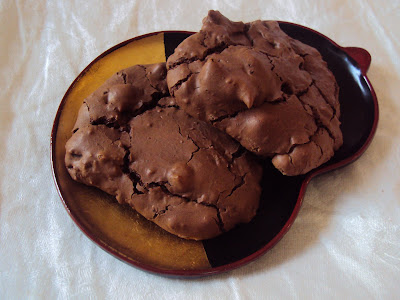Every girl needs a failsafe chocolate cake recipe. I have two favourites: a dense loaf cake from Nigella Lawson, and the ‘ultimate’ brownie from, of all places, a fashion magazine. Oh, I’ve tried other recipes, but the flavour is either missing or bitter. For me, fabulous fudginess is guaranteed only by Nigella or Glamour.
Now I have another chocolate favourite, thanks to my friend M. And my goodness, is it fabulous and fudgy. And – fast. Why, how? Because it is a brownie disguised as a biscuit. Yes, you read that right. It has the shiny, crackled top and the decadent squidgy texture within of a good brownie, but whereas a brownie takes around 45 minutes to bake, these little beauties take only 15. That’s right, only 15 minutes before you’re on a chocolate buzz, thinking (all at once): why didn’t I double the recipe? The diet starts tomorrow; I need a tall glass of cold milk; will I have any left to take to work? The kitchen still smells like chocolate!
Or, of course, your brain could be just blank – blissed out on brownie biscuits (note the plural).
Thank you, M!
Brownie biscuits
Adapted from an Observer recipe emailed by M. I halved the original recipe (now I wish I hadn’t!) because I blanched at the thought of using almost half a kilo of chocolate in one recipe. Though as M wisely said, ‘Just ignore the amount of chocolate and focus on how they taste; that’s how I approach these cookies’. Oh, and I think these are best warm, so do zap them in the microwave for a few seconds to get that chocolate all fudgy again. Made ten.
- Preheat your oven to 170 and prep a baking tray.
- A little further prep: chop 100 gms dark cooking chocolate into chunks and set aside for later.
- Put 25 gms butter and another 100 gms dark cooking chocolate in a heatproof bowl over a saucepan of simmering water and melt gently, stirring until smooth. Remove from heat.
- Whisk together 1 egg, 85 gms light brown sugar and ¼ tspn vanilla until combined.
- Pour in the melted chocolate mix and whisk again to combine (a free standing beater comes in handy here).
- Fold thru about 40 gms plain flour, ¼ tspn salt and ¼ tspn baking powder, then add the chopped chocolate (be sure to lick the spoons and bowls for this one!).
- Drop spoonfuls onto your baking tray then bake for 15 minutes; the tops will look shiny and will crack apart. They’ll still be soft when you remove them from the oven so leave to cool on the trays for a few minutes before transferring to a wire rack. Or into your mouth.













